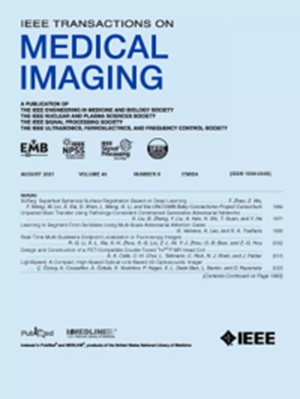基于快速χ欧拉特征的医学图像分割拓扑优化。
IF 9.8
1区 医学
Q1 COMPUTER SCIENCE, INTERDISCIPLINARY APPLICATIONS
引用次数: 0
摘要
基于深度学习的医学图像分割技术在基于传统指标(如Dice分数或交集-over- union)进行评估时显示出了有希望的结果。然而,这些全自动方法往往不能满足临床可接受的精度,特别是当需要观察拓扑约束时,例如连续边界或封闭表面。在医学图像分割中,根据所需的拓扑属进行分割的正确性有时甚至比像素精度更重要。现有的拓扑感知方法通常通过持久同构(PH)的概念来估计和约束拓扑结构。然而,这些方法由于其多项式计算复杂度而难以实现高维数据。为了克服这一问题,我们提出了一种基于欧拉特征(χ)的新颖快速的拓扑感知分割方法。首先,我们提出了二维和三维χ计算的快速公式。预测值与真值之间的标量χ误差作为拓扑评价指标。然后,我们通过所谓的拓扑冲突图来估计任何分割网络的空间拓扑正确性,即突出显示具有χ误差的区域的详细地图。最后,利用拓扑感知校正网络对任意网络的分割结果进行拓扑冲突映射的细化。我们在2D和3D数据集上进行了实验,结果表明我们的方法可以显著提高拓扑正确性,同时保持像素级分割的准确性。本文章由计算机程序翻译,如有差异,请以英文原文为准。
Topology Optimization in Medical Image Segmentation with Fast χ Euler Characteristic.
Deep learning-based medical image segmentation techniques have shown promising results when evaluated based on conventional metrics such as the Dice score or Intersection-over-Union. However, these fully automatic methods often fail to meet clinically acceptable accuracy, especially when topological constraints should be observed, e.g., continuous boundaries or closed surfaces. In medical image segmentation, the correctness of a segmentation in terms of the required topological genus sometimes is even more important than the pixel-wise accuracy. Existing topology-aware approaches commonly estimate and constrain the topological structure via the concept of persistent homology (PH). However, these methods are difficult to implement for high dimensional data due to their polynomial computational complexity. To overcome this problem, we propose a novel and fast approach for topology-aware segmentation based on the Euler Characteristic (χ). First, we propose a fast formulation for χ computation in both 2D and 3D. The scalar χ error between the prediction and ground-truth serves as the topological evaluation metric. Then we estimate the spatial topology correctness of any segmentation network via a so-called topological violation map, i.e., a detailed map that highlights regions with χ errors. Finally, the segmentation results from the arbitrary network are refined based on the topological violation maps by a topology-aware correction network. Our experiments are conducted on both 2D and 3D datasets and show that our method can significantly improve topological correctness while preserving pixel-wise segmentation accuracy.
求助全文
通过发布文献求助,成功后即可免费获取论文全文。
去求助
来源期刊

IEEE Transactions on Medical Imaging
医学-成像科学与照相技术
CiteScore
21.80
自引率
5.70%
发文量
637
审稿时长
5.6 months
期刊介绍:
The IEEE Transactions on Medical Imaging (T-MI) is a journal that welcomes the submission of manuscripts focusing on various aspects of medical imaging. The journal encourages the exploration of body structure, morphology, and function through different imaging techniques, including ultrasound, X-rays, magnetic resonance, radionuclides, microwaves, and optical methods. It also promotes contributions related to cell and molecular imaging, as well as all forms of microscopy.
T-MI publishes original research papers that cover a wide range of topics, including but not limited to novel acquisition techniques, medical image processing and analysis, visualization and performance, pattern recognition, machine learning, and other related methods. The journal particularly encourages highly technical studies that offer new perspectives. By emphasizing the unification of medicine, biology, and imaging, T-MI seeks to bridge the gap between instrumentation, hardware, software, mathematics, physics, biology, and medicine by introducing new analysis methods.
While the journal welcomes strong application papers that describe novel methods, it directs papers that focus solely on important applications using medically adopted or well-established methods without significant innovation in methodology to other journals. T-MI is indexed in Pubmed® and Medline®, which are products of the United States National Library of Medicine.
 求助内容:
求助内容: 应助结果提醒方式:
应助结果提醒方式:


